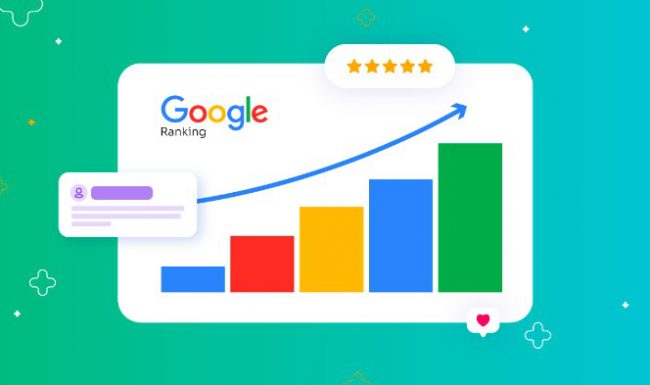This module will teach you everything you need to know about Google ranking and how it’s determined for your dental website, from context and settings to 10 key factors. By understanding Google ranking and how Google ranks content, you can optimize your dental website to improve online visibility, attract more potential patients, and increase practice revenue.

Here’s why this module is focused on Google ranking and how it’s determined for your dental website.
In our three previous modules, we took a deep dive into three important questions about search engine optimization (SEO) and the fundamentals behind each, which lay the groundwork for this module:
In the above modules, we explained some of the workings and principles behind SEO to rank your dental website higher in search engines, and we focused on ranking in Google for a reason.
Google certainly isn’t the only search engine in town. The list of top-used search engines includes Bing, Yahoo, and Yandex. Yet Google reigns supreme in the search engine market, with an 89% share of the U.S. search engine market and a 90% share of the global market. So, focusing on SEO to improve your dental website ranking on Google makes the most sense in terms of Google’s reach and potential website traffic generated from SEO.
At the same time, when you optimize your dental website for ranking on Google, you optimize your dental website for better ranking and discovery on other search engines. As explained by SEO expert and Crazy Egg founder Neil Patel, “Most of your Google optimization efforts work well to help other search engines understand your content and website architecture.”
Before we dive further into Google ranking and how it’s determined for your dental website

If you missed one of our previous SEO modules above, we encourage you to go through them before jumping into this module. The foundational SEO knowledge covered in our previous modules is an important primer to understanding Google ranking and how it’s determined for your dental website. If you have gone through the three previous modules and certain SEO terms haven’t quite locked in yet, our blog SEO for Dentists (An In-Depth Guide) serves as a handy reference as you go through this module.
Let’s dive in.

Fundamentally, Google ranks websites based on value. Despite its domination of the search engine market, Google is a business like any other business. They’re in the business of delivering the best possible search results to user queries. If they can’t do that, they risk losing users to other search engines, and that has happened.
In 2015, for example, Google’s share of the search market fell from 77.3% to 75.2% of searches when Mozilla signed a partnership to use Yahoo as its default search engine rather than Google. Bing has also grown its share of the global search engine market from 3.14% to 5.9%. Given the previously mentioned 90% figure, Google obviously grew its share of the global search engine market. To keep it, Google’s search algorithms examine many factors and signals related to websites and queries to deliver the most valuable and relevant search results possible for user queries from hundreds of billions of web pages.
To return relevant search results for queries, Google’s algorithms begin by examining the words entered in a search bar to determine the intent of a query. This involves a range of things, from recognizing and correcting spelling mistakes to using a sophisticated synonym system that enables Google to return relevant search results, even if the results don’t contain the exact words used in a query.
Google’s algorithms also try to understand the type of information that a query seeks, including local intent. If a potential dental patient searches for “dental practice near me,” for example, Google delivers search results about a nearby dental practice.
Google’s algorithms next assess which web pages contain information that is likely relevant to a query, with the most basic signal being keywords that match a query. Beyond keywords, Google’s algorithms assess other relevant content like images and videos but are not designed to assess concepts, such as opinions expressed in the content.
Next, Google’s algorithms prioritize web pages that demonstrate expertise, authority, and trustworthiness, with a key signal being backlinks—links to a web page from a third-party website viewed as well-trusted. Aggregated feedback from Google’s search quality evaluation process is also used to further refine the process.
Website experience aspects play a significant role in search results. Web pages that are mobile-friendly, for example, are given precedence because they can more easily be viewed by users on mobile devices. Similarly, websites in alignment with Web Content Accessibility Guidelines may perform better in search results, and websites that load quickly may perform better because users want and expect websites that load quickly. “Like us,” writes Google Search Central, “our users place a lot of value in speed—that’s why we’ve decided to take site speed into account in our search rankings.”
A user’s location, past search history, and search settings (e.g., preferred language) also play a part in Google’s algorithms to additionally help ensure search results are useful and relevant for a query. If a potential patient in your area queries “dentist near me,” for example, Google may present search results featuring specific dental services like pediatric dental practices if a user has previously searched for dental care information related to children.

The previously mentioned factors—meaning of a query, relevance of content, quality of content, the usability of pages, and context and settings—all factor into Google ranking and how it’s determined for your website.
A bit more about the specifics behind Google’s ranking of search results:
Google has trained its natural-language models to interpret text, search queries, and even audio and video content to understand the meaning of a user query. Google mainly uses natural-language processing in the following areas:
A bit more about some of the mechanisms behind search results and Google ranking:
To better understand the nuances and context of words in searches and better match those queries with more relevant results, Google rolled out the machine-learning algorithm BERT in 2019 to improve search query interpretation. Short for Bidirectional Encoder Representations from Transformers, BERT considers the full context of a word by examining the words that come before and after it.
An acronym for Multitask Unified Model, the MUM algorithm (introduced in 2021) is a multimodal algorithm designed to break language barriers and improve search experiences by taking complex queries and providing one answer without doing multiple searches. Working with artificial intelligence, MUM (1,000 times more powerful than BERT) also understands images, video, and audio files.
The above two algorithms highlight what was underscored in our first SEO module[XB4] . From removing right-side paid ads (AdWords) in desktop searches in 2018 to BERT and MUM, Google is continually making changes to its algorithms to ensure users receive the best possible results to searches. Yet such changes can impact SEO and thereby rankings in Google and how it’s determined for your dental website, which reinforces the need for dental practices to do two things connected to Google ranking:

Google calculates content relevance to queries by different factors:
Keywords that match a query are the most basic signal of content relevance. Keywords used in the headings, subheadings, and body of content signals Google that content may be more relevant to a search.
Google ranks original, helpful, and up-to-date information higher in search results than content that’s out of date and sounds like it has been cut and pasted from another website. “Google pays special attention to your content quality,” writes MonsterInsights. “No matter how optimized your webpage is, if your content is not valuable, then you can’t expect higher rankings.” This is why dental marketing service providers like ProSites provide custom website content as part of dental websites as one of the most effective ways to improve SEO and thereby Google ranking.
Google prioritizes content that fully responds to a user’s needs and provides detailed information/solutions. Writes HubSpot, “Research has proven time and time again that content that covers all areas, whether long or short form, tends to do better in search results.”
Organic click-through rates to your website help Google understand whether people like your content. If more people are clicking through to one of your web pages, Google’s algorithms will view your content as more relevant to an associated keyword and rank you higher for it.
Longer is generally better when it comes to content and Google ranking. The sheer ability of a long word count naturally enables content to cover a subject in-depth. “According to different studies,” writes MonsterInsights, “content length has a significant impact on where you rank on the search results. On average, posts in the first 10 position on Google search have 1,890 words.”

Have you ever rolled your eyes at one of those blogs that use some statistic (“80% of dentists agree!”) but fail to attribute the source or provide a link to show they’re not just making stuff up?
If so, you have an idea of how Google’s algorithms also view such content. They come off as suspicious, which is why Google views such content as low quality and ranks it accordingly.
To help ensure this doesn’t happen to your dental practice website content:
Ensure that your content is authoritative, trustworthy, and offers a high level of expertise, all embodied in Google’s E-E-A-T search quality standards, which include experience. In alignment with delivering valuable search results, Google added experience in 2022 in acknowledgment of situations where users most value “content produced by someone who has first-hand, life experience on the topic at hand,” and dental professionals naturally have most or all E-E-A-T quality standards in spades.
Use references from authoritative and trusted websites. When attributing information in your content, name the source, whether a dental organization, fellow dental professional, or organization viewed as a trusted source of information about a subject.
Link your content to authoritative and trusted websites. As an element of source attribution or statement qualification, linking to authoritative and trusted websites includes linking to recognized experts in a field relevant to the content.
Ensure that your content is well-researched, meaning content that contains relevant data from different reliable sources. When you show potential patients that your content can be trusted, you show them that you and your dental practice can be trusted.

We’ve touched on some of the major factors related to Google ranking and how it’s determined for your dental website. Yet Backlinko’s list of Google’s 200 ranking factors evidence there is many factors related to ranking in Google, including:
And as we’ve already covered in this module, links factor into Google ranking because Google’s PageRank algorithm still applies.
Developed in 1998 at Stanford University by Google’s founders Sergey Brin and Larry Page, PageRank assigned web page importance (and thereby ranking) based on a page’s links. Though Google has since introduced many other algorithms and ranking factors, PageRank remains active and important to rankings in Google in that PageRank’s mathematical formula looks at the number of inbound links and external links for a web page to determine authority. “The higher the PageRank score of a page,” writes HubSpot, “the more authoritative that page is.”
Relevant, high-quality content (as previously mentioned) is an important Google ranking factor, as are keywords. In tandem with this, keyword placement is important.

Keywords should be used up front in content—in meta descriptions (to influence click-through), content titles, and the first paragraph of content. Keywords should also be used in content subheadings and body content across all pages, from your Contact Us page to staff bios, which should also include authority and trust factors to help with Google ranking. In staff bio content, for example, include information like professional credentials, years of practice, etc.
The overall guiding principle in keyword placement is to use them naturally and avoid keyword stuffing—attempting to manipulate search rankings through repeated use of words of phrases.
“Keyword stuffing,” writes Search Engine Journal, “is a confirmed negative ranking factor.”
In terms of content pieces themselves, authority and trust are extra important in connection with content that Google deems “Your Money or Your Life” (YMYL)—content that could potentially impact a person’s future happiness, health, financial stability, or safety if presented inaccurately.
Since the subject of dentistry is a YMYL topic, practices need to ensure credentials and other key authority information is clearly presented in dental content.
While there are many available tools to find keywords and track their performance, Google Search Console is one of the most accessible.
>> Here’s a quick rundown to quickly get started with Google Search Console

Image optimization is an important factor in SEO and helping your dental website with Google ranking, particularly when it comes to page load speed. As Google writes, “Images are often the largest contributor to overall page size, which can make pages slow and expensive to load,” meaning the slower your website pages load (a usability issue), the more your website negatively impacts Google ranking, and the more potential patients will be inclined to abandon your website.
To hedge against all this:
Resize images according to what is required on your website. High-resolution images can come with huge file sizes and reduce website load speed.
Choose the right image format. PNG images are better-quality images but come with a large file size, versus JPEG images, which contain fewer data than PNG files.
Use images moderately. Cluttering up web pages with too many images can slow website load speed, and visually, too many images can be distracting and even annoying for patients.
If your dental practice serves a niche market (e.g., dental technology that emphasizes facial beauty), focusing on content related to your niche tells Google that you’re a trusted source in that niche. So, you’re chances of ranking for niche-associated keywords go up. “Dominating your niche on Google can be very profitable,” writes Search Engine Watch. “Ranking well for keywords related to your specific niche helps drive higher quality traffic to your site and differentiates your brand.”

As previously mentioned, page speed and having a mobile-friendly website are important technical factors for ranking in Google. Equally important:

We’re mentioning it again to re-emphasize their importance to your dental website and Google ranking. Backlinks (links back to your website from third-party websites) are key parts of a complete dental SEO strategy because they are authority, trust, and expertise signals for Google.
Google local ranking factors involve relevance, distance, prominence, and local ranking signals—all covered in our third SEO module, What Is Local SEO?”

Q: What affects Google’s ranking?
A: Many things affect Google ranking, including content relevance and quality, on- and off-page factors, technical factors, and more covered in this module.
Q: How does Google rank content?
A: Google ranks content according to many factors, including keywords, valuable and unique insights, content length, and organic click-through rates.
Q: Why is it important to check your Google rankings?
A: Monitoring your ranking in Google helps you make SEO adjustments to maintain ranking and visibility to attract more potential patients and keep your dental chairs full.
Q: How many Google ranking factors are there?
A: There are roughly 200 Google ranking factors.
Q: How long will it take to see ranking success?
A: Depending on where your dental website currently ranks on Google’s search engine results pages, it can take anywhere from three to six months to rank on the first page of Google.
Q: Why did Google show that result?
A: Many factors influence what search results Google delivers for a query, with the main ones being how Google’s algorithms interpret the meaning of a query.
Q: How does Google measure on-page experience?
A: Google’s measurement of on-page experience includes Core Web Vitals, mobile usability, and HTTPS usage.
Q: How do I improve my Google ranking?
A: This is certainly the big question for most (if not all) dental practices today. In a competitive dental market where people are increasingly searching online for health care providers (including dental practices), more dental practices want to know how to improve their ranking in Google, and accomplishing that has been the point of these SEO modules. With a careful and thorough SEO strategy, your dental practice can rank higher in search engines to attract more patients and increase revenue, and yes. Putting an SEO strategy can take time—something that can be in short supply for practices.
This explains why more dental practices are using online marketing providers like ProSites.
Trusted by dental practices everywhere and endorsed by 15 dental organizations, ProSites helps practices thrive with a comprehensive suite of website design, SEO, and internet marketing services to help dental practices attract, engage, and connect with more patients. By taking advantage of ProSites’ comprehensive suite of services, dental practices can increase their online presence, attract more patients, and achieve measurable results.